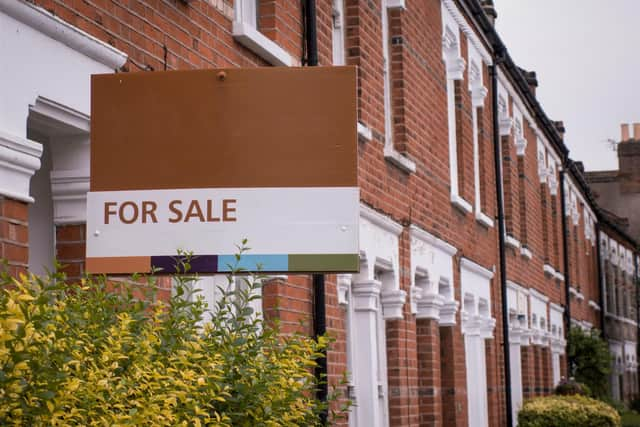York: Gap between earnings and house prices increased by more than £200k since 1997
New data from the Office for National Statistics shows that in 1997, the median house price in York was £57,500, which is £41,998 more than the median workplace earnings at £15,502.
However, in 2023, the median house price was £300,000, which is £265,891 more than the median workplace earnings at £34,109.
Advertisement
Hide AdAdvertisement
Hide AdCoun Michael Pavlovic, executive member for housing at the City of York Council, said: “These figures show earnings have increased by 220 per cent, but the price of a home by more than five times over the past 25 years.


“This shows us housing affordability has become a huge problem in York, one that’s pricing out the next generation of homeowners.
“The knock-on effect on rental values is also huge, meaning an increasing percentage of household income is committed to housing costs.
“The effect is a decline in the standard of living for those working hard and aspiring to own their own homes.
Advertisement
Hide AdAdvertisement
Hide Ad“Not until the government moves beyond empty commitments and delivers significant numbers of new homes across the country over a sustained period will this situation change."
House prices increased incrementally in York until 2009, following the financial crisis, before climbing again between 2010 and 2023.
The data shows York now has the highest average house prices in Yorkshire and the Humber.
It has a similar affordability rate as some areas in the south of England, like Milton Keynes and Cheltenham.
Advertisement
Hide AdAdvertisement
Hide AdAdam Corlett, principal economist at the Resolution Foundation, said: “Britain’s housing crisis is likely to be a big topic in the election campaign, as parties debate how to address the problems of high costs, poor quality and low security that face so many households.
“Britain is one of many countries apparently in the midst of a housing crisis, and it can be difficult to separate rhetoric from reality.
"But by looking at housing costs, floorspace and wider issues of quality, we find that the UK’s expensive, cramped and ageing housing stock offers the worst value for money of any advanced economy.
“Britain’s housing crisis is decades in the making, with successive governments failing to build enough new homes and modernise our existing stock.
“That now has to change.”
Advertisement
Hide AdAdvertisement
Hide Ad| Year | Median house price (£) | Median workplace earning (£) | Affordability ratio |
| 1997 | 57,500 | 15,502 | 3.71 |
| 1998 | 60,000 | 16,832 | 3.56 |
| 1999 | 61,995 | 17,023 | 3.64 |
| 2000 | 72,000 | 19,349 | 3.72 |
| 2001 | 85,000 | 19,917 | 4.27 |
| 2002 | 105,000 | 21,048 | 4.99 |
| 2003 | 131,000 | 21,077 | 6.22 |
| 2004 | 145,950 | 22,442 | 6.5 |
| 2005 | 161,495 | 23,260 | 6.94 |
| 2006 | 167,000 | 22,822 | 7.32 |
| 2007 | 177,000 | 24,912 | 7.11 |
| 2008 | 179,950 | 25,128 | 7.16 |
| 2009 | 163,000 | 25,169 | 6.48 |
| 2010 | 173,000 | 24,346 | 7.11 |
| 2011 | 175,000 | 24,960 | 7.01 |
| 2012 | 177,000 | 26,277 | 6.74 |
| 2013 | 180,000 | 27,604 | 6.52 |
| 2014 | 190,000 | 25,880 | 7.34 |
| 2015 | 210,000 | 25,622 | 8.2 |
| 2016 | 216,500 | 26,113 | 8.29 |
| 2017 | 227,500 | 26,448 | 8.6 |
| 2018 | 235,000 | 26,508 | 8.87 |
| 2019 | 243,250 | 29,611 | 8.21 |
| 2020 | 250,000 | 31,096 | 8.04 |
| 2021 | 275,000 | 32,501 | 8.46 |
| 2022 | 295,000 | 33,077 | 8.92 |
| 2023 | 300,000 | 34,109 | 8.8 |
Some academics have argued that house prices have increased more slowly with less foreign investment in the British housing market.
Research carried out by Dr Filipa Sa, senior lecturer in economics at King’s College London, shows that with no foreign investment in the housing market in England and Wales between the years 2000 and 2014, house prices would be 19 per cent lower than they are now.
Dr Sa said, "This problem isn’t unique to the UK – other countries, such as Australia, Switzerland and Canada have also been debating this issue and have introduced policies to control foreign investment in the housing market.
Advertisement
Hide AdAdvertisement
Hide Ad"This is certainly an issue that we need to continue focussing on so that current and future generations can afford to create their own homes across the UK."
The government’s latest budget announcement included measures for housing, published on the Department for Levelling Up, Housing and Communities’ website.
It reads: “Driving faster housing delivery means supporting all types of housebuilders – including communities who want to build for themselves.
“A new £20 million investment in social finance will build up to 2,000 to 3,000 new homes and improve the capacity of local community groups to deliver housing.
Advertisement
Hide AdAdvertisement
Hide Ad“Recognising the crucial role that local authorities have in delivering more affordable housing, we are increasing the cap (from 40 per cent to 50 per cent) on the percentage of the cost of a replacement that can be funded from Right to Buy receipts.”
Comment Guidelines
National World encourages reader discussion on our stories. User feedback, insights and back-and-forth exchanges add a rich layer of context to reporting. Please review our Community Guidelines before commenting.
